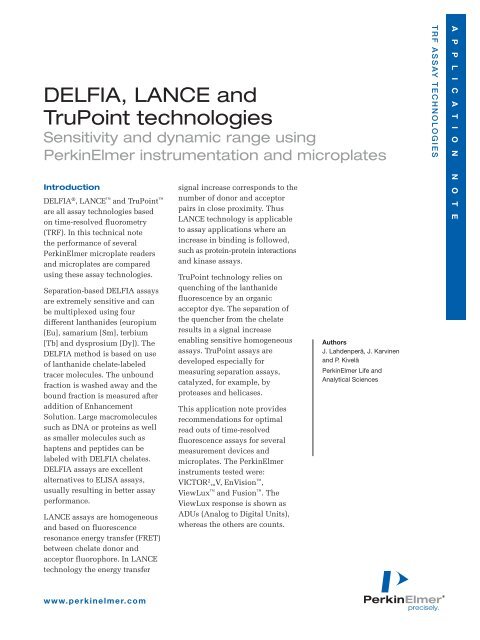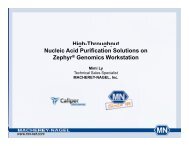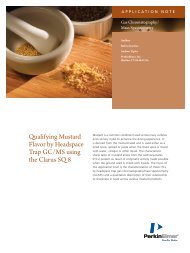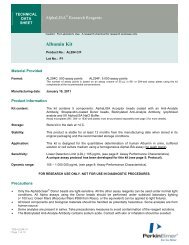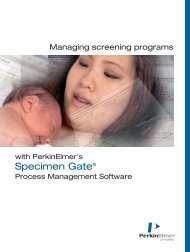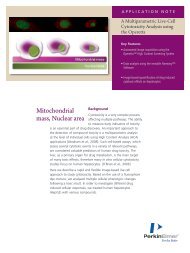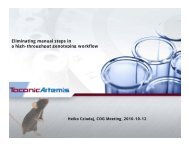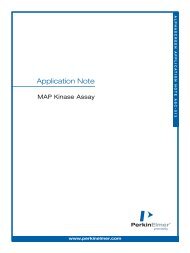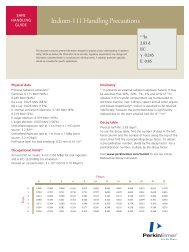DELFIA, LANCE and TruPoint technologies ... - PerkinElmer
DELFIA, LANCE and TruPoint technologies ... - PerkinElmer
DELFIA, LANCE and TruPoint technologies ... - PerkinElmer
Create successful ePaper yourself
Turn your PDF publications into a flip-book with our unique Google optimized e-Paper software.
<strong>DELFIA</strong>, <strong>LANCE</strong> <strong>and</strong><br />
<strong>TruPoint</strong> <strong>technologies</strong><br />
Sensitivity <strong>and</strong> dynamic range using<br />
<strong>PerkinElmer</strong> instrumentation <strong>and</strong> microplates<br />
Introduction<br />
<strong>DELFIA</strong> ® , <strong>LANCE</strong> <strong>and</strong> <strong>TruPoint</strong> <br />
are all assay <strong>technologies</strong> based<br />
on time-resolved fluorometry<br />
(TRF). In this technical note<br />
the performance of several<br />
<strong>PerkinElmer</strong> microplate readers<br />
<strong>and</strong> microplates are compared<br />
using these assay <strong>technologies</strong>.<br />
Separation-based <strong>DELFIA</strong> assays<br />
are extremely sensitive <strong>and</strong> can<br />
be multiplexed using four<br />
different lanthanides (europium<br />
[Eu], samarium [Sm], terbium<br />
[Tb] <strong>and</strong> dysprosium [Dy]). The<br />
<strong>DELFIA</strong> method is based on use<br />
of lanthanide chelate-labeled<br />
tracer molecules. The unbound<br />
fraction is washed away <strong>and</strong> the<br />
bound fraction is measured after<br />
addition of Enhancement<br />
Solution. Large macromolecules<br />
such as DNA or proteins as well<br />
as smaller molecules such as<br />
haptens <strong>and</strong> peptides can be<br />
labeled with <strong>DELFIA</strong> chelates.<br />
<strong>DELFIA</strong> assays are excellent<br />
alternatives to ELISA assays,<br />
usually resulting in better assay<br />
performance.<br />
<strong>LANCE</strong> assays are homogeneous<br />
<strong>and</strong> based on fluorescence<br />
resonance energy transfer (FRET)<br />
between chelate donor <strong>and</strong><br />
acceptor fluorophore. In <strong>LANCE</strong><br />
technology the energy transfer<br />
signal increase corresponds to the<br />
number of donor <strong>and</strong> acceptor<br />
pairs in close proximity. Thus<br />
<strong>LANCE</strong> technology is applicable<br />
to assay applications where an<br />
increase in binding is followed,<br />
such as protein-protein interactions<br />
<strong>and</strong> kinase assays.<br />
<strong>TruPoint</strong> technology relies on<br />
quenching of the lanthanide<br />
fluorescence by an organic<br />
acceptor dye. The separation of<br />
the quencher from the chelate<br />
results in a signal increase<br />
enabling sensitive homogeneous<br />
assays. <strong>TruPoint</strong> assays are<br />
developed especially for<br />
measuring separation assays,<br />
catalyzed, for example, by<br />
proteases <strong>and</strong> helicases.<br />
This application note provides<br />
recommendations for optimal<br />
read outs of time-resolved<br />
fluorescence assays for several<br />
measurement devices <strong>and</strong><br />
microplates. The <strong>PerkinElmer</strong><br />
instruments tested were:<br />
VICTOR 2 V, EnVision ,<br />
ViewLux <strong>and</strong> Fusion . The<br />
ViewLux response is shown as<br />
ADUs (Analog to Digital Units),<br />
whereas the others are counts.<br />
Authors<br />
J. Lahdenperä, J. Karvinen<br />
<strong>and</strong> P. Kivelä<br />
<strong>PerkinElmer</strong> Life <strong>and</strong><br />
Analytical Sciences<br />
TRF ASSAY TECHNOLOGIES<br />
A P P L I C A T I O N N O T E<br />
www.perkinelmer.com
Methods<br />
Instrument performance<br />
comparison: <strong>DELFIA</strong><br />
Instrument performance was tested<br />
by measuring a dilution series of<br />
Eu-labeled streptavidin in <strong>DELFIA</strong><br />
Enhancement Solution ( 1 /2-log steps<br />
from 6.3 x 10 -4 g/L to 2 x 10 -12 g/L).<br />
Microplates tested were white <strong>and</strong><br />
black OptiPlate -96, white<br />
OptiPlate-384 <strong>and</strong> <strong>DELFIA</strong> yellow<br />
96-well microplates. Europium<br />
concentration in the sample was<br />
normalized against a 1 nM europium<br />
st<strong>and</strong>ard solution for accurate<br />
sensitivity determination.<br />
Microplates were measured with<br />
VICTOR 2 V, EnVision, ViewLux<br />
<strong>and</strong> Fusion instruments (settings<br />
presented in Table 1). For best<br />
results, any material that could<br />
contain europium, such as glass,<br />
was avoided. Pipette tips were<br />
soaked with <strong>DELFIA</strong> Enhancement<br />
Solution for 5 minutes <strong>and</strong> then<br />
filled <strong>and</strong> emptied a couple of times<br />
with the <strong>DELFIA</strong> Enhancement<br />
Solution before use.<br />
Instrument performance<br />
comparison: <strong>LANCE</strong> <strong>and</strong><br />
<strong>TruPoint</strong><br />
The <strong>PerkinElmer</strong> <strong>LANCE</strong> Tyrosine<br />
Kinase Start-up Reagent Package<br />
(Eu-labeled anti-phosphotyrosine<br />
antibody, APC labeled Streptavidin<br />
<strong>and</strong> biotinylated positive control<br />
phosphopeptide) was used in<br />
testing. The instruments were<br />
compared with two different<br />
assays using black <strong>and</strong> white 384-<br />
well OptiPlates: 1) a dilution series<br />
of positive control <strong>and</strong> 2) diluting<br />
all the reaction components,<br />
starting from 10 nM phosphopeptide,<br />
50 nM SA-APC <strong>and</strong> 1 nM Eulabeled<br />
anti-P-Tyr antibody <strong>and</strong><br />
making a series of 1:1 dilutions.<br />
Data is useful when determining<br />
the optimal assay conditions <strong>and</strong><br />
the minimum requirements for a<br />
Table 1. Instrument settings, <strong>DELFIA</strong><br />
Protocol VICTOR 2 V EnVision ViewLux Fusion<br />
Table<br />
Measurement Height 8.00 mm 3.00 mm 3.00 mm N/A<br />
Measurement Delay 400 µs 400 µs 401 µs 400 µs<br />
Measurement Window 400 µs 400 µs 354 µs 400 µs<br />
Measurement Cycle 1,000 µs 2,000 µs 1,000 µs N/A<br />
Measurement 1 100 30 80<br />
Time or Flashes sec/well flashes/well sec/plate flashes/well<br />
Table 2. Instrument settings, <strong>LANCE</strong> <strong>and</strong> <strong>TruPoint</strong><br />
Protocol VICTOR 2 V EnVision ViewLux Fusion<br />
Table<br />
Measurement Height 8.00 mm 5.00 mm 3.00 mm N/A<br />
Measurement Delay 50 µs 60 µs 50 µs 50 µs<br />
Measurement Window 100 µs 100 µs 354 µs 100 µs<br />
Measurement Cycle 1,000 µs 2,000 µs 1,000 µs N/A<br />
Measurement 1 100 15 80<br />
Time or Flashes sec/well flashes/well sec/plate flashes/well<br />
Table 3. The europium detection sensitivities measured with <strong>DELFIA</strong> technology.<br />
Measurement time of a single plate is also presented for each instrument.<br />
Sensitivity Table Device Europium amol/well Time/plate<br />
Detection<br />
(min)<br />
Limit (M)<br />
White 96-well VICTOR 2 V 6.3E-15 1.3 2:08<br />
OptiPlate EnVision 2.8E-14 5.5 1:06<br />
Fusion 1.6E-14 3.3 2:48<br />
Black 96-well VICTOR 2 V 2.7E-14 5.4<br />
OptiPlate EnVision 2.1E-14 4.3<br />
Fusion 5.6E-13 113.0<br />
Yellow 96-well VICTOR 2 V 2.2E-14 4.3<br />
<strong>DELFIA</strong> plate EnVision 3.0E-14 6.0<br />
Fusion 1.1E-13 21.0<br />
White 384-well VICTOR 2 V 4.9E-14 2.5 7:38<br />
OptiPlate EnVision 2.4E-14 1.2 2:41<br />
Fusion 6.3E-14 3.1 8:26<br />
ViewLux 2.6E-13 12.9 1:12<br />
reliable assay. The detection<br />
sensitivities were determined for<br />
the same instruments that were<br />
tested with the <strong>DELFIA</strong> assay. Table 2<br />
summarizes the instrument settings.<br />
The <strong>PerkinElmer</strong> Caspase-3 Kit was<br />
used as a model for the <strong>TruPoint</strong><br />
time-resolved fluorescence quenching<br />
assay. The kit consists of a<br />
quenched caspase-3 substrate,<br />
caspase-3 assay buffer <strong>and</strong><br />
microplates needed for the measurement.<br />
The caspase-3 enzyme was<br />
purchased from R&D Systems<br />
(Minneapolis, MN, USA). Black <strong>and</strong><br />
white OptiPlate-96, OptiPlate-384<br />
<strong>and</strong> OptiPlate-1536 were tested<br />
with 200 nM substrate <strong>and</strong> different<br />
enzyme concentrations. All other<br />
assay conditions were as recommended<br />
in the kit manual. Total<br />
assay volumes used were 50, 25 <strong>and</strong><br />
5 mL for 96-, 384- <strong>and</strong> 1536-well<br />
2
microplates, respectively. The<br />
instrument settings for <strong>TruPoint</strong><br />
measurements were the same as<br />
those used with <strong>LANCE</strong>.<br />
Figure 1.<br />
<strong>DELFIA</strong> europium measured<br />
with white OptiPlate-96.<br />
Results<br />
Instrument performances for<br />
detecting diluted europium with<br />
<strong>DELFIA</strong> are summarized in Table<br />
3. The graphical data are presented<br />
in Figures 1, 2, 3 <strong>and</strong> 4.<br />
Instrument performance with the<br />
<strong>LANCE</strong> Tyrosine Kinase Start-up<br />
reagents was determined using two<br />
approaches: detection sensitivity<br />
for the peptide dilution series <strong>and</strong><br />
sensitivity for a diluted reaction<br />
(see Methods). Summary of these<br />
measurements is presented in<br />
Table 4, <strong>and</strong> the graphical data in<br />
Figures 5, 6, 7 <strong>and</strong> 8.<br />
Summary of the <strong>LANCE</strong> sensitivity<br />
data is presented in Table 4. The<br />
lowest concentration of reagents<br />
producing a Z'-value > 0.5 was used<br />
as a measurement of sensitivity.<br />
Data show that detection sensitivity<br />
is dependent upon the type of<br />
microplate used. EnVision clearly<br />
outperforms the other instruments<br />
in terms of sensitivity <strong>and</strong> reagent<br />
consumption per well when a<br />
black microplate is used. With the<br />
white microplate the reagent costs<br />
is also lowest with EnVision (see<br />
Z'-factor at diluted reaction<br />
column).<br />
Results from the caspase-3 enzyme<br />
titration measurements with<br />
<strong>TruPoint</strong> are presented in Figures<br />
9, 10, 11, 12, 13 <strong>and</strong> 14. The Z'-<br />
values with 0.5 ng/mL enzyme<br />
calculated from four replicates <strong>and</strong><br />
the measurement times with<br />
different instruments are presented<br />
in Table 5. The ViewLux was the<br />
fastest of the instruments tested<br />
with a microplate processing time<br />
of 70 seconds/plate regardless of<br />
the plate type.<br />
Figure 2.<br />
<strong>DELFIA</strong> europium measured<br />
with black OptiPlate-96.<br />
Figure 3.<br />
<strong>DELFIA</strong> europium measured<br />
with yellow 96-well <strong>DELFIA</strong><br />
plate.<br />
Figure 4.<br />
<strong>DELFIA</strong> europium measured<br />
with white OptiPlate-384.<br />
www.perkinelmer.com<br />
3
Summary of the <strong>LANCE</strong> sensitivity<br />
data is presented in Table 4. The<br />
lowest concentration of reagents<br />
producing a Z'-value > 0.5 was used<br />
as a measurement of sensitivity.<br />
Data show that detection sensitivity<br />
is dependent upon the type of<br />
microplate used. EnVision clearly<br />
outperforms the other instruments<br />
in terms of sensitivity <strong>and</strong> reagent<br />
consumption per well when a black<br />
microplate is used. With the white<br />
microplate the reagent costs is also<br />
lowest with EnVision (see Z'-factor<br />
at diluted reaction column).<br />
Results from the caspase-3 enzyme<br />
titration measurements with <strong>TruPoint</strong><br />
are presented in Figures 9, 10, 11, 12,<br />
13 <strong>and</strong> 14. The Z'-values with 0.5<br />
ng/mL enzyme calculated from four<br />
replicates <strong>and</strong> the measurement times<br />
with different instruments are<br />
presented in Table 5. The ViewLux<br />
was the fastest of the instruments<br />
tested with a microplate processing<br />
time of 70 seconds/plate regardless<br />
of the plate type.<br />
Table 4. Instrument performance comparison with <strong>LANCE</strong>. Sensitivity was determined<br />
for peptide dilution series <strong>and</strong> for dilution series of the whole reaction. Assay producing<br />
a Z'-factor > 0.5 was used as a determination of minimum amount of reaction components<br />
needed. Trend is a calculation method for the detection sensitivity.<br />
Sensitivity Table Diluted Peptide (nM) Diluted Reaction (nM)<br />
Z' > 0.5 Detection Z' > 0.5 Detection<br />
Limit<br />
Limit<br />
White 384- VICTOR 2 V 0.111 0.017 0.155 0.070<br />
OptiPlate ViewLux 0.257 0.022 0.073 0.011<br />
EnVision 0.224 0.048 0.130 0.033<br />
Fusion 0.285 0.029 0.362 0.055<br />
Black 384- VICTOR 2 V 0.548 0.097 0.550 0.349<br />
OptiPlate ViewLux 1.193 0.095 0.638 0.334<br />
EnVision 0.242 0.073 0.295 0.097<br />
Fusion 1.068 0.258 1.833 0.402<br />
Table 5. Z'-values <strong>and</strong> measurement times for different instruments <strong>and</strong> microplates<br />
in <strong>TruPoint</strong> assays<br />
VICTOR 2 V EnVision ViewLux Fusion<br />
Z' Meas. Z' Meas. Z' Meas. Z' Meas.<br />
Time* Time Time Time<br />
White 96-well 0.98 1.26 0.98 0.58 0.95 1.10 0.98 2.53<br />
Black 96-well 0.90 0.94 0.97 0.94<br />
White 384-well 0.90 3.24 0.93 2.35 0.89 1.10 0.98 8.47<br />
Black 384-well 0.63 0.69 0.72 0.71<br />
White 1536-well 0.80 14.35 0.87 9.16 0.91 1.10 0.82 32.02<br />
Black 1536-well 0.75 0.77 0.73 0.69<br />
* minutes<br />
Figure 5.<br />
<strong>LANCE</strong> instrument<br />
performance for peptide<br />
dilution series measured<br />
with white OptiPlate-384.<br />
Figure 6.<br />
Instrument performance in<br />
<strong>LANCE</strong> for diluted reaction<br />
measured with white<br />
OptiPlate-384. X-axis presents<br />
the dilution factor where 1 is<br />
composed of 10 nM peptide,<br />
50 nM SA-APC <strong>and</strong> 1 nM<br />
Eu-labeled anti-P-Tyr antibody<br />
diluted in the assay buffer<br />
<strong>and</strong> where 0.1 corresponds<br />
components diluted 1:10 in<br />
the reaction buffer.<br />
4
Figure 7. <strong>LANCE</strong> instrument performance for peptide<br />
dilution series measured with black OptiPlate-384.<br />
Figure 11. <strong>TruPoint</strong> assay with white OptiPlate-384<br />
Figure 8. <strong>LANCE</strong> instrument performance for diluted reaction<br />
measured with black OptiPlate-384. X-axis presents the dilution factor<br />
where 1 is composed of 10 nM peptide, 50 nM SA-APC <strong>and</strong> 1 nM<br />
Eu-labled anti-P-Tyr antibody diluted in the assay buffer <strong>and</strong> where<br />
0.1 corresponds components diluted 1:10 in the reaction buffer.<br />
Figure 12. <strong>TruPoint</strong> assay with black OptiPlate-384<br />
Figure 9. <strong>TruPoint</strong> assay with white OptiPlate-96.<br />
Figure 13. <strong>TruPoint</strong> assay with white OptiPlate-1536.<br />
Figure 10. <strong>TruPoint</strong> assay with black OptiPlate-96.<br />
Figure 14. <strong>TruPoint</strong> assay with black OptiPlate-1536.<br />
www.perkinelmer.com<br />
5
Conclusions<br />
<strong>DELFIA</strong> technology is a very<br />
sensitive method for quantitative<br />
analysis of proteins, DNA, RNA or<br />
even lipids using <strong>PerkinElmer</strong><br />
multilabel counters. The detection<br />
limit for europium is clearly under<br />
10 amol/well. There were some<br />
differences in sensitivities between<br />
the different instruments, the<br />
VICTOR <strong>and</strong> EnVision having the<br />
best sensitivity. All the instruments<br />
were compatible with all the<br />
microplates tested with <strong>DELFIA</strong><br />
technology. Dynamic range, which<br />
is usually the most valuable factor<br />
when setting up robust assays, was<br />
about 5 decades with VICTOR <strong>and</strong><br />
EnVision instruments, where as the<br />
Fusion was limited to about 3<br />
decades. All the instruments<br />
showed that the best dynamic range<br />
<strong>and</strong> good detection sensitivity was<br />
obtained with the yellow microplate<br />
that is specifically designed for<br />
<strong>DELFIA</strong> technology.<br />
<strong>LANCE</strong> technology is utilized in<br />
many applications, for example in<br />
kinase <strong>and</strong> protein-protein interaction<br />
assays as well as in hybridization<br />
assays for nucleic acids. The<br />
instrument performances for<br />
<strong>LANCE</strong> assay were evaluated by<br />
using two different methods. In the<br />
first approach the minimum target<br />
amount for detection of positive<br />
signal was determined by making<br />
dilutions of the phosphorylated<br />
peptide while the concentration of<br />
all the other reagents was kept<br />
constant. The second assay measured<br />
dilutions of all the reaction<br />
components to find out the minimum<br />
amounts needed for a reliable<br />
assay. The results revealed that<br />
screening assay costs will be lower<br />
with EnVision compared to the<br />
other instruments tested because it<br />
enables use of lower amounts of<br />
reaction components. Considering<br />
these low costs in combination with<br />
its rapid plate measurement, the<br />
Envision is a very attractive instrument<br />
for routine use in a screening<br />
laboratory. The most sensitive<br />
instrument for phosphopeptide<br />
measurements with black<br />
microplates was also EnVision, but<br />
VICTOR outperformed EnVision<br />
when white microplates were used.<br />
<strong>TruPoint</strong> is an assay method based<br />
on time-resolved fluorescence<br />
quenching <strong>and</strong> has been developed<br />
to measure activity of hydrolyzing<br />
enzymes. With the <strong>TruPoint</strong> assay,<br />
use of white microplates resulted in<br />
better sensitivity than black ones<br />
with all of the instruments. Thus in<br />
applications measuring low enzyme<br />
activities, such as measurement of<br />
protease activity from cell lysates,<br />
the use of white microplates is<br />
recommended. There were no<br />
significant differences in plates of<br />
different densities indicating that<br />
<strong>TruPoint</strong> assays developed in 96- or<br />
384-well formats are easily miniaturizable<br />
into the 1536-well format.<br />
The white microplates tested were<br />
not compatible with the Fusion in<br />
the <strong>TruPoint</strong> assay as the PMT of<br />
the instrument became saturated<br />
with the wells having high enzyme<br />
concentrations. The Z' values were<br />
comparable with all of the instruments.<br />
Even though the Z' values<br />
were lower with black microplates<br />
compared to the white ones, the use<br />
of black microplates is recommended<br />
for HTS applications. The black<br />
microplates have better tolerance<br />
for library compounds absorbing at<br />
the europium emission wavelength<br />
thus reducing the number of false<br />
positives in HTS.<br />
Microplate reading times were also<br />
compared for the different instruments.<br />
The reading times with<br />
ViewLux were clearly shortest due<br />
to the imaging technology used.<br />
EnVision outperformed VICTOR<br />
<strong>and</strong> Fusion, especially in <strong>LANCE</strong><br />
assays where EnVision utilized a<br />
dual measurement mode which is<br />
not available for VICTOR or Fusion.<br />
Both EnVision <strong>and</strong> ViewLux are<br />
extremely fast plate readers for high<br />
throughput screening, while<br />
VICTOR <strong>and</strong> Fusion are better<br />
suited for research <strong>and</strong> assay<br />
development purposes.<br />
6
Available Products<br />
Product No.<br />
Description<br />
6005290 OptiPlate-96 (96-well white microplate, 50 plates)<br />
6005270 Optiplate-96 F (96-well black microplate, 50 plates)<br />
6007290 OptiPlate-384 (384-well white microplate, 50 plates)<br />
6007270 OptiPlate-384 F (384-well black microplate, 50 plates)<br />
6005228 OptiPlate-1536 (1536-well white opaque microplate, 20 plates)<br />
6005235 OptiPlate-1536 F (1536-well black microplate, 20 plates)<br />
AAAND-0001 <strong>DELFIA</strong> Yellow Plate (96-well microplate, 60 plates)<br />
AD0121 <strong>LANCE</strong> Tyrosine Kinase Start Up Reagents<br />
Includes: AD066 (50 µg) <strong>LANCE</strong> Eu-W1024 anti-pTyr antibody (PY100)<br />
AD067 (1 mg) <strong>LANCE</strong> Eu-W1024 anti-pTyr antibody (PY100)<br />
CR130-100 (1 mg) SureLight APC-Streptavidin<br />
CR130-150 (50 mg) SureLight APC-Streptavidin<br />
Biotinylated poly(Glu, Tyr) kinase substrate<br />
Biotinylated phosphotyrosine peptide (positive control)<br />
6007290 OptiPlate-384 white<br />
1244-360 <strong>DELFIA</strong> Eu-labeled Streptavidin, 250 µg<br />
B119-100 <strong>DELFIA</strong> 1 nmol/L Europium St<strong>and</strong>ard Solution, 50 mL<br />
AD0125 <strong>TruPoint</strong> Caspase-3 Assay Kit, 2 plates<br />
2101 EnVision Multilabel Plate Reader<br />
1420 VICTOR 2 V Multilabel Plate Reader<br />
1430 ViewLux Multilabel Plate Imager<br />
Not available Fusion Multilabel Plate Reader<br />
www.perkinelmer.com<br />
7
<strong>PerkinElmer</strong> Life <strong>and</strong><br />
Analytical Sciences<br />
710 Bridgeport Avenue<br />
Shelton, CT 06484-4794 USA<br />
Phone: (800) 762-4000 or<br />
(+1) 203-925-4602<br />
www.perkinelmer.com<br />
For a complete listing of our global offices, visit www.perkinelmer.com/lasoffices<br />
©2004 <strong>PerkinElmer</strong>, Inc. All rights reserved. The <strong>PerkinElmer</strong> logo <strong>and</strong> design are registered trademarks of <strong>PerkinElmer</strong>, Inc. <strong>DELFIA</strong>, EnVision, Fusion, <strong>LANCE</strong>, <strong>TruPoint</strong>, VICTOR, <strong>and</strong><br />
ViewLux are trademarks or registered trademarks of <strong>PerkinElmer</strong>, Inc. or its subsidiaries, in the United States <strong>and</strong> other countries. All other trademarks not owned by <strong>PerkinElmer</strong>, Inc. or its<br />
subsidiaries that are depicted herein are the property of their respective owners. <strong>PerkinElmer</strong> reserves the right to change this document at any time <strong>and</strong> disclaims liability for editorial,<br />
pictorial or typographical errors.<br />
007088_01 Printed in USA


